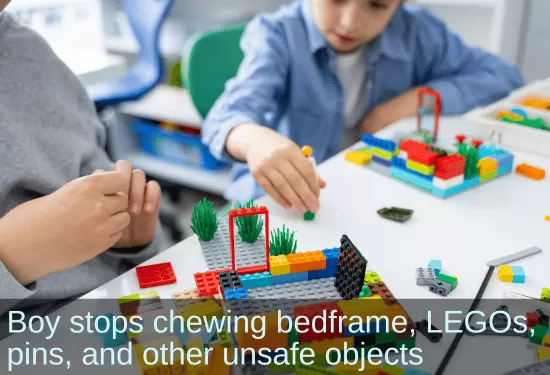Primitive Reflex Integration Case Studies
No More Compulsive Chewing After Reflex Integration
Chewing of non-food items ends in 5 weeks
This 8-year-old boy chewed many inappropriate and dangerous objects, including pins and LEGOs. His OT provided rhythmic movements and reflex integration using tools from the Brain and Sensory Foundations course, and in just 5 weeks eliminated all chewing of non-food items!
Submitted by Shivani Moodley, Occupational Therapist

| Before | After |
|---|---|
| Frequently chewing non-edible and at times unsafe objects, such as pins, his bed frame, uniform collar, and Lego blocks | Chewing of non-food items completely stopped |
B is 8 years old and was referred to me with the challenge of frequently chewing non-edible and at times unsafe objects, such as pins, his bed frame, uniform collar and Lego blocks. His parents’ goal was for B to stop chewing non-food objects.
I chose the following neurodevelopmental movements:
• All of the rhythmic movements as the foundation for the reflex integration, and to help to calm and organise his brain and nervous system.
• Hand reflex integration as the hand is linked to the mouth, and upon testing, his hand reflexes were unintegrated.
• Feet reflex integration as I know that feet can be linked to the mouth during development.
• Moro reflex integration as he presented with an unintegrated Moro reflex, and his psychologist mentioned that he presents with a great deal of anxiety.
B enjoyed the rhythmic movements and requested them for longer periods during each session. He was initially eager to try the different activities presented, but did not enjoy the Moro exercises, reporting that he felt these were challenging. B did not enjoy the hand reflex stimulation, reporting that these were painful, but enjoyed the integration exercises. His parents were great with continuing activities throughout the week when I did not see him, which assisted in reducing the discomfort with the Moro and hand reflex exercises.
The 5-Step Balance was also done with B. The goal created with B was “I will sit at my desk and not chew on my collar.” We proceeded through the steps, using the rhythmic movements and hand reflex integration tools. When B acted out the goal again, he reported that it felt easier for him to do the second time, and that he had less of a desire to chew on his collar.
I was pleasantly surprised to learn that after 5 weeks of weekly 1 hour sessions with B, his chewing of non-food items completely stopped. He was no longer chewing on his uniform collar or bed frame, and his parents were thrilled and also surprised that simple exercises that given this result. This has shown me that the intensity of exercises is not always what matters, such as doing hard exercises with the hand to strengthen the hand, but that providing neurodevelopmental input to the brain is such a crucial piece of the puzzle that I had been missing in my therapy.
(Edited, emphasis added)
*Disclaimer: The activities in the Brain and Sensory Foundations curriculum make use of the natural processes of neuroplasticity and development that are innately wired in the design of human beings to promote maturity and function. These activities appear to calm, organize, and mature the neuro-sensory-motor systems just as we see in the healthy development of human infants. Individual results may vary, and we do not claim to offer a diagnosis or cure for any specific condition or disorder. The Brain and Sensory Foundations activities appear to improve overall functioning resulting in measurable improvements for a range of conditions as demonstrated in over 1800 case studies from participants.

